Over
the past several years, ACDelco® has reviewed, inspected and reinstalled hundreds of air conditioning
compressors returned under warranty. The failure of these compressors can be grouped into four basic
modes: lubrication, refrigerant, debris and product defects.
The
exact percentage of each mode varies slightly among
models and manufacturers, but in general, about 1/3 of
the compressors failed from lubrication problems,
approximately 1/3 failed from refrigeration problems,
slightly less than 1/3 failed from assorted internal
debris, and the 1–2% balance were associated with
various manufacturing defects.
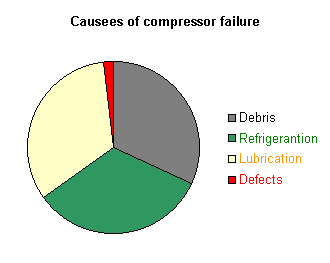
Be assured that ACDelco®
has been actively working with the various
manufacturers to incorporate quality and reliability
enhancements into the compressors to reduce and
eliminate the manufacturing defects. However, the
majority of warranty returns — many of them repeat
compressor replacements — can be attributed to factors
all under the control of the installer.
In a
medical emergency, a triage is often performed at the
hospital to quickly and accurately define the problem
and provide proper follow-up care. A similar situation
should take place when a customer
arrives with an A/C refrigeration condition at a
service center.
Procedures enacted here will pay immediate as well as
long term benefits. These A/C triage procedures would
include:
1.
Quickly and accurately assess and confirm the
condition
2. Find and stop refrigerant loss
3. Clean and contain internal debris and contaminants
4. Replace missing fluids
5. Provide professional follow-up
Assess and Confirm the Condition
When
inspecting many replaced compressors, they are deemed
NTF (No Trouble Found) because the initial review was
inadequate. It failed to verify the root cause. A
quick visual prevents needless replacement caused by
low charge, Diagnostic Trouble Codes (DTC), electrical
connections, loose fasteners, etc. Quick checks for
proper charge levels and purity as well as electrical
confirmation of clutch engagement will significantly
reduce the number of times a good compressor is
replaced.
Stop
Refrigerant Loss (or Stop the Bleeding)
Refrigerant is vital to the short and long term
operation of a compressor.
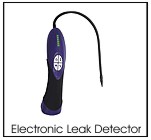 It
is the refrigerant that is responsible for
transporting the lubricant throughout the system. Low
or no refrigerant will not provide adequate compressor
lubrication. As mentioned earlier, low refrigerant and
poor lubrication account for nearly two-thirds of the
replacement compressor warranty returns. Replacing a
compressor WILL NOT ensure that the refrigerant leak
is fixed. It only takes a few minutes to check with
both a UV light and a quality electronic leak detector
to confirm that there are NO OTHER leaks. Vacuum and
pressure leak checking will not locate leaks that will
take out a compressor in one-to-three months. The loss
of one ounce per month may be a 20% system loss on
some vehicles during this period. This low charge will
cause compressor noise, an irate customer and a NTF
compressor return.
It
is the refrigerant that is responsible for
transporting the lubricant throughout the system. Low
or no refrigerant will not provide adequate compressor
lubrication. As mentioned earlier, low refrigerant and
poor lubrication account for nearly two-thirds of the
replacement compressor warranty returns. Replacing a
compressor WILL NOT ensure that the refrigerant leak
is fixed. It only takes a few minutes to check with
both a UV light and a quality electronic leak detector
to confirm that there are NO OTHER leaks. Vacuum and
pressure leak checking will not locate leaks that will
take out a compressor in one-to-three months. The loss
of one ounce per month may be a 20% system loss on
some vehicles during this period. This low charge will
cause compressor noise, an irate customer and a NTF
compressor return.
Clean and Contain Internal Debris and Contaminants
Prior to as well as after compressor failure, debris
particles from the failure flow throughout the
refrigerant system — in BOTH directions. Although a
majority of debris travels downstream from the
compressor, upon shut down and equalization of
remaining refrigerant, the flow reverses and does flow
from the compressor suction port toward the suction
muffler, hose, A/D and evaporator. These particles
imbed themselves in various internal components and
cannot be 100% flushed out. They will find their way
back into the replacement compressor.
In
addition to debris, the refrigerant lubrication may be
burnt or contaminated from improper sealant or
refrigerant. As with the medical field, successful
treatment requires cleaning the damaged area and
providing treatment, which will prevent future
infection.
The
first step is to inspect and clean or replace the
existing system debris containment components. These
include the orifice tube, TXV screen(s), A/D or R/D
and any inline filter.
The
A/D or R/D cannot be service cleaned. The general rule
of thumb for A/D or R/D replacement is:
•
A/D or R/D age over three years
• Sealant inclusion within the system
• Significant debris found within the system after
compressor failure In addition to reviewing the
existing OEM filtration devices, it is important to
remember that the OEM system was installed with a
certified clean system. Once a component fails, the
only way to ensure the system is completely, 100%
clean is by replacing all A/C components, which is
rather impractical. Therefore, it is critical for the
service technician to provide protective devices not
originally included in the OEM system (they were not
needed under factory new conditions) to prolong
service repair life. ACDelco recommends the use of a
suction screen on all compressor replacements where
the replacement compressor does not come with an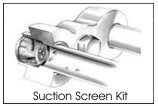 internal suction screen (for example, A-6, V-5 and V-7
models).
internal suction screen (for example, A-6, V-5 and V-7
models).
The
installation of the low-cost suction screen provides
additional protection to the precision replacement
compressor installed in a compromised environment.
In
addition to the suction screen, ACDelco has redesigned
the in-line filter employed to prevent rear TXV’s and
orifice tubes from premature plugging. This filter
offers the additional filter debris capacity to
maintain system integrity. This newly redesigned
in-line filter is a universal one-size-fits-all part
that has a significantly increased debris containment
screen and a technician-friendly leak-free
installation design. In addition, it can be employed
as a line splice for repairing leaks on A/C lines to
rear systems.
Flushing is mentioned often in the aftermarket as the
panacea to system contamination. Flushing will remove
lubricant from the system and will remove some, but
not all, of the debris within the system. However,
flushing is an expensive process.
Since contamination is generally spread throughout the
system after compressor failure, not to flush the
entire system would be similar to changing just the
shirt of a small child who had fallen in the mud. The
kid’s still not clean and neither is the system
without flushing.
In
addition, all OEM’s except Ford insist on refrigerant
flushing only if flushing is to take place. Ford
allows solvent flushing, but only using an endorsed
flushing material and with the approved flushing
equipment. As mentioned previously, flushing does not
100% guarantee particle removal, so preventive suction
and line filters are highly recommended to capture
those elusive remaining particles. The aftermarket use
of sealants has provided the service industry a repair
dilemma. There are currently numerous chemical
sealants employed in the automotive A/C service
industry. No OEM currently endorses the use of
sealants. However, given the thousands of sales made
to the do-it-yourselfer and repair shops, they will be
in vehicles you service.
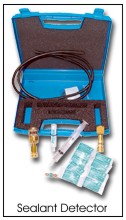 Removal is dependent upon the amount and type of
sealant employed. There currently is no method for
100% removal of sealants (short of total component
replacement). A/D or R/D replacement will greatly
reduce system sealant quantities but not completely
remove it from the system. In addition, the
refrigerant and associated lubricant removed by
recovery equipment assists to minimize the level of
total system contamination. Of importance to
technicians with this recovery is protection of their
expensive recovery equipment from sealant. There are
no tools to identify all the sealants employed in the
automotive aftermarket. Therefore, the use of a
seal-ant protection device or seal-ant
detector prior to
running the recovery equipment is a worthwhile
investment.
Removal is dependent upon the amount and type of
sealant employed. There currently is no method for
100% removal of sealants (short of total component
replacement). A/D or R/D replacement will greatly
reduce system sealant quantities but not completely
remove it from the system. In addition, the
refrigerant and associated lubricant removed by
recovery equipment assists to minimize the level of
total system contamination. Of importance to
technicians with this recovery is protection of their
expensive recovery equipment from sealant. There are
no tools to identify all the sealants employed in the
automotive aftermarket. Therefore, the use of a
seal-ant protection device or seal-ant
detector prior to
running the recovery equipment is a worthwhile
investment.
Replace Missing Fluids
There are two important fluids that must be replaced
in proper quantity and quality. These are lubricant
and refrigerant. The compressor manufacturer must
approve the lubricant. The use of ACDelco lubricant
assures warranty coverage and OEM specifications
adherence. No OEM automotive compressor manufacturer
endorses the use of esters. Their use will void the
warranty from ACDelco.
The
second lubrication issue is to ensure an adequate
amount. A lubrication replacement balance guide is
included with re-placement compressors. Failure to
heed these guidelines to lubrication replacement after
component replacement or flush can and will cause
premature failure and replacement.
Finally, refrigerant quality and quantity is critical
in today’s automotive A/C system. Today’s systems will
lose performance and reliability as well as create
noise if the charge is not kept within the
manufacturer’s specification.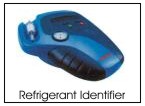
The
use of 12 ounce cans will not provide this accuracy.
Current charge equipment, when maintained, will
provide charges within the +/- 1 ounce tolerance often
required. In addition, if a refrigerant identifier is
not
employed after charging, there is no way to ensure
that excessive air or alternate refrigerants are
present. After charging, both of these contaminants
will cause noise and premature compressor failure.
Provide Professional
Follow-up
The term professional
follow-up means more then being paid to repair an A/C
system. It means the ability to provide the customer
with qualified diagnostics and quality OEM replacement
parts and service materials. Rechecking the details
prior to final customer release is very important. The
reinspection of the entire system for leaks,
functional testing with a thermometer, checking gauge
pressures and performing purity tests will ensure
customer satisfaction.
Remember, quality parts also require quality
installation and attention to detail.